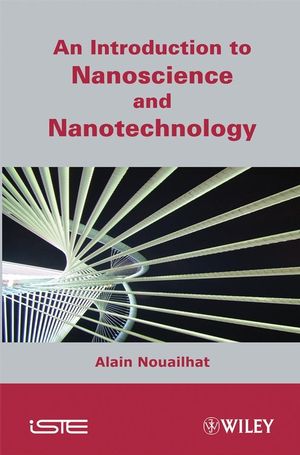An Introduction to Nanoscience and NanotechnologyISBN: 978-1-84821-007-3
Hardcover
256 pages
January 2008, Wiley-ISTE
 |
||||||
Foreword xiii
Acknowledgements xv
Preface xvii
Chapter 1. What are Nanos? 1
1.1. What are we talking about? 3
1.2. References 7
1.2.1. Two basic facts 7
1.2.2. Two approaches 9
1.2.3. Two key points 11
1.3. Some bonus material for economists 13
Chapter 2. Some Science to Get You Started 15
2.1. Quantum physics 17
2.1.1. From the traditional world to the quantum world 17
2.1.2. Two fundamental concepts 19
2.1.2.1. Wave-corpuscle duality 19
2.1.2.2. Probability in the quantum world 21
2.2. The key players 22
2.2.1. The electron 22
2.2.1.1. The cornerstone of matter 22
2.2.1.2. Electronic states 23
2.2.1.3. The quantification of energy 24
2.2.1.4. Bonds 25
2.2.2. The photon 27
2.2.2.1. The wave 27
2.2.2.2. The energy grain 30
2.3. Molecules 34
2.3.1. From the smallest molecule to the largest and their spectacular properties 34
2.3.2. Functionality 35
2.4. Solid matter 36
2.4.1. Insulators or conductors. 36
2.4.2. Semi-conductors 37
2.4.2.1. Silicon crystal 37
2.4.2.2 Electrons and holes 40
2.4.2.3 Junctions 40
2.4.3. Nanomaterials 41
2.5. Quantum boxes: between the atom and the crystal 41
2.6. Some bonus material for physicists 42
2.6.1 Luminescence 42
2.6.2. The laser device 44
Chapter 3. The Revolution in Techniques Used in Observation and Imagery 51
3.1. Observing with photons 53
3.1.1. The optical microscope in visible light 53
3.1.2. X-ray machines 54
3.2. Observing with electrons 55
3.2.1. The transmission electron microscope (TEM) 55
3.2.2. The scanning electron microscope (SEM) 56
3.3. Touching the atoms 58
3.4. Observing how our brain functions 60
3.4.1. Nuclear magnetic resonance 60
3.4.2. Functional magnetic resonance imaging 61
3.5. Some bonus material for researchers 62
Chapter 4. The Marriage of Software and Hardware 69
4.1. Small is beautiful 71
4.2. Miniaturization 71
4.3. Integration 72
4.3.1. The silicon planet 72
4.3.2. An expanding universe 78
4.4. Programs 82
4.5. Some bonus material for mathematicians 83
Chapter 5. Mechanics of the Living World 89
5.1. Proteins – molecules with exceptional properties 93
5.1.1. The program of cellular production 94
5.1.2. Reading instructions and the production of proteins 95
5.1.3. How does it work? 99
5.1.4. Molecular disfunctioning 100
5.1.4.1. External causes 100
5.1.4.2. Internal causes 100
5.2. Intervention of human beings 101
5.2.1. Medication 102
5.2.2. The creation of those famous GMOs (Genetically Modified Organisms) 102
5.2.3. Manipulation of embryos 103
5.3. Some bonus material for biologists 103
Chapter 6. The Uses of Nanotechnologies 107
6.1. New objects 109
6.1.1. Carbon in all its states 109
6.1.1.1. Nanodiamonds 110
6.1.1.2. Carbon nanotubes 110
6.1.2. A handful of gold atoms 116
6.2. Ground-breaking products 116
6.2.1. Surface treatment 117
6.2.2. Incorporation in a composite environment 119
6.3. From micro to nanosystems 120
6.3.1. Miniature components – MEMS 120
6.3.1.1. A print head for inkjet printers 120
6.3.1.2. Airbags 122
6.3.1.3. A microlens for miniaturized optics 123
6.3.1.4. Magnetic disk readheads: quantum nanostructures 124
6.3.2. Microsources of energy: key points for embedded systems 124
6.3.3. Micromotors 125
6.4. A global integration 132
6.5. Some bonus material for engineers 139
Chapter 7. Nanos are Changing the World 143
7.1. A simulation or a virtual world 145
7.2. Understanding nature 151
7.2.1. Understanding energy 151
7.2.2. Understanding materials 152
7.2.3. Understanding information 154
7.2.4. Understanding life 156
7.3. Watch out for nanomedicine 159
7.4. Nanosciences and our future 161
7.5. Essential ethics 165
7.6. Conclusion 169
Appendices 173
Appendix A. European Parliament Resolution on Nanosciences and Nanotechnologies 175
Appendix B. Eight Guidelines on Nanotechnologies Issued by the CNRS Ethics Committee 185
Abbreviations 191
Bibliography 195
Figures 197
Index 205



